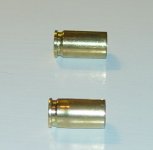I have decided to begin reloading for my 9 mm and 38 spl handguns. I am retired and have the time to prepare carefully for this. I have read all of "A, B, C's of Reloading", as well as all of Lyman's 49th and Speer's #14 as they relate to general info on reloading. I have purchased a tumbler, a digital scale and an analog scale, and other accessories. I will complete the prep process when I finally purchase the Dillon 550B, case gauge, dies, etc. from Dillon. I have determined my first load for my three 9 mm pistols (S&W M&P 9C, Kahr CM9, and Sig P226) and bought a hundred 124 gr. Precision Delta FMJ bullets. I intend to hit a gun show this weekend and hopefully get the needed powder and primers without a hazmat fee.
I don't take this less than seriously as I don't wish to damage myself or any of the five handguns I have purchased in the last year. In addition to the texts mentioned above, I have read a bunch from forums on the internet trying to learn all I can on the subject. I thought I was in good shape until this evening when I encountered a problem I couldn't resolve from my usual reading sources, so I thought I'd ask you guys.
I was sorting my tumbled 9 mm brass (factory loads shot once by me) according to headstamp. I noticed that a small percentage of my Federal brass from factory (Walmart) rounds had bulges close to the head. I read all I could find about this on the net and in the manuals, and it seems that a certain amount of this is to be expected and will be handled OK via the resizing process. To investigate a bit more, I field stripped my three 9 mm pistols and dropped some of the once-fired cases into the chambers of the barrels. I quickly found that not only did the once-fired cases with slight bulges fail to cleanly fit the chambers, but others failed to as well - even though there was no easy, visual evidence of expansion in them. This was true for Winchester and other brass as well, but not to the extent I saw it in Federal brass. There was some expansion in some of my once-fired 38 special cases, also, but not nearly as much as in the 9 mm cases. I suppose that, especially due to the taper on the 9 mm case, all once-fired 9 mm cases are left in a state where the cases are expanded. That's what the resizing is for. But how much expansion (prior to reloading) is acceptable? Expansion is understandable, but I was surprised to literally see bulging. Why is there any bulging near the head as these are factory loads? What about the cases whose bulge is actually visible? Will the resizing die handle this? At what point in the reloading process do I make the decision as to keep or toss a given piece of brass? After resizing? Or should I toss the small percentage of Federal cases now just because there is a visible bulge?
Here is a pic showing a Federal case with the bulge and another brand case where no such bulge is apparent.

Thanks for any help you can give......
I don't take this less than seriously as I don't wish to damage myself or any of the five handguns I have purchased in the last year. In addition to the texts mentioned above, I have read a bunch from forums on the internet trying to learn all I can on the subject. I thought I was in good shape until this evening when I encountered a problem I couldn't resolve from my usual reading sources, so I thought I'd ask you guys.
I was sorting my tumbled 9 mm brass (factory loads shot once by me) according to headstamp. I noticed that a small percentage of my Federal brass from factory (Walmart) rounds had bulges close to the head. I read all I could find about this on the net and in the manuals, and it seems that a certain amount of this is to be expected and will be handled OK via the resizing process. To investigate a bit more, I field stripped my three 9 mm pistols and dropped some of the once-fired cases into the chambers of the barrels. I quickly found that not only did the once-fired cases with slight bulges fail to cleanly fit the chambers, but others failed to as well - even though there was no easy, visual evidence of expansion in them. This was true for Winchester and other brass as well, but not to the extent I saw it in Federal brass. There was some expansion in some of my once-fired 38 special cases, also, but not nearly as much as in the 9 mm cases. I suppose that, especially due to the taper on the 9 mm case, all once-fired 9 mm cases are left in a state where the cases are expanded. That's what the resizing is for. But how much expansion (prior to reloading) is acceptable? Expansion is understandable, but I was surprised to literally see bulging. Why is there any bulging near the head as these are factory loads? What about the cases whose bulge is actually visible? Will the resizing die handle this? At what point in the reloading process do I make the decision as to keep or toss a given piece of brass? After resizing? Or should I toss the small percentage of Federal cases now just because there is a visible bulge?
Here is a pic showing a Federal case with the bulge and another brand case where no such bulge is apparent.

Thanks for any help you can give......

